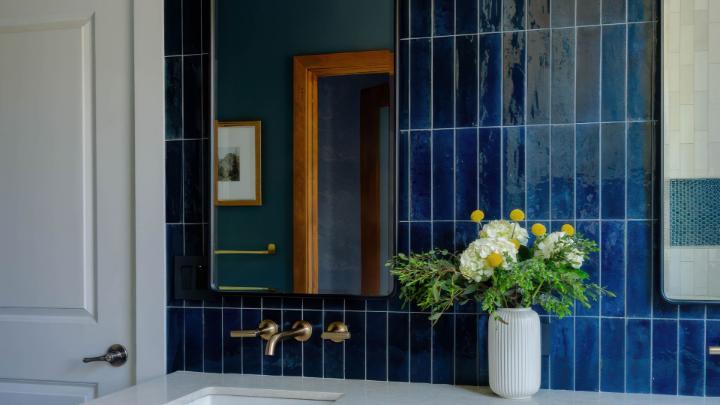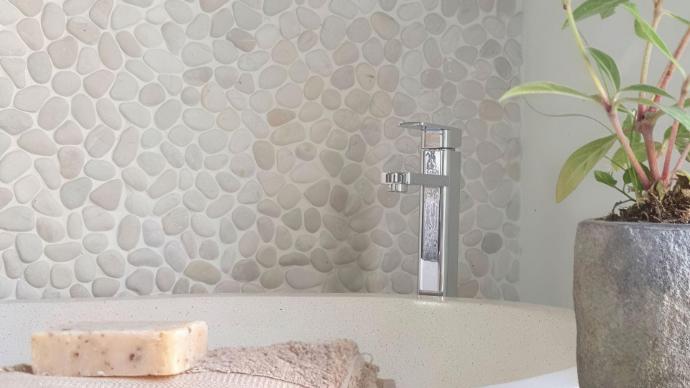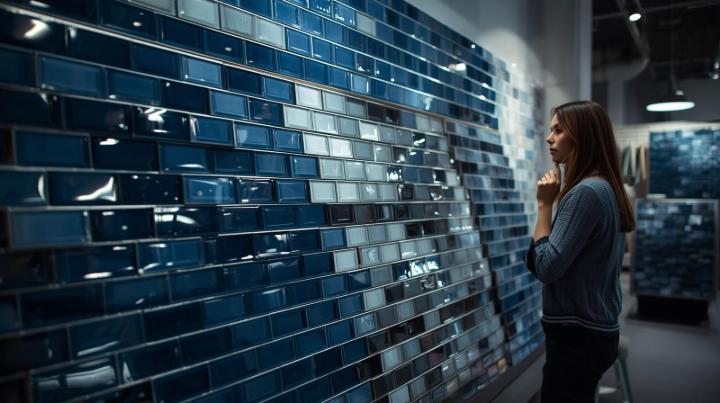Subway tiles come in classic neutrals (white, black, gray, beige, cream, ivory), bold colors (blue, green, yellow, red, orange), and various materials (ceramic, porcelain, glass, natural stone). White subway tile remains most popular for its timeless versatility, while gray offers modern adaptability and bold colors like navy or emerald create dramatic focal points.
Light colors make small spaces appear larger by reflecting light, whereas dark colors add sophistication to larger rooms. When choosing subway tile colors, consider room lighting, existing décor, and desired mood. Ceramic is the most affordable with wide color selection, porcelain offers durability, glass provides reflective brightness, and natural stone delivers luxury.
Timeless Neutral Shades
While white subway tile maintains its status as a design staple, an array of neutral tones provides comparably adaptable alternatives. When selecting tiles by color, consider how each shade interacts with your space and how dimension impacts visual effect when you shop tiles by size.
Black
Black subway tile delivers a confident design statement, bringing sophistication and contemporary flair to any environment. It produces compelling contrast alongside paler shades and works beautifully in minimalist aesthetics when combined with streamlined forms and industrial features. Pairing with metallic touches like gold or copper generates an opulent appearance.
Gray
Gray subway tile delivers exceptional adaptability in interior spaces. Paler grays create an open and modern atmosphere, whereas darker variations add richness and intensity. Gray blends seamlessly with wood's natural warmth, marble's refined elegance, and stainless steel's sleek appearance, making it versatile for both cool and warm palettes.
Cream and Ivory
Cream and ivory subway tiles radiate quiet sophistication and coziness. Their gentle tones create inviting environments that integrate smoothly with both classic and modern design styles. Combined with chrome or nickel hardware, they produce a refined appearance and function as an ideal foundation for adding color accents.
Beige and Tan
Natural beige and tan subway tiles convey organic warmth and peace. Matching beautifully with wood features, natural textiles, and greenery, they create balanced settings. The NKBA Planning Guidelines help ensure your tile layout achieves both aesthetic harmony and functional efficiency by aligning with professional design best practices.
Vibrant and Dynamic Colors
For those looking to inject personality into their environments, colorful subway tiles present abundant opportunities. Exploring options when you shop tiles by style helps identify which aesthetic approaches best complement your color preferences.
Blue
Blue subway tile presents a flexible range of atmospheres. Gentle pastel blues create peaceful environments, while richer tones like cobalt or navy add drama and elegance. Blue combines seamlessly with white cabinets and chrome fixtures, producing a fresh look that aligns with kitchen trends 2025 emphasizing sophisticated color choices.
Green
Green subway tile fills environments with freshness and vigor. Gentle mint greens create bright, positive settings ideal for kitchens and bathrooms, while richer tones like emerald or forest green add drama. Green pairs well with wood elements and organic materials.
Yellow
Yellow subway tile immediately enlivens any space. Gentle buttery yellows create cozy environments, whereas vibrant lemon yellows bring spirited elements. Design professionals highlight yellow's effectiveness in compact areas, as demonstrated in these small kitchen floor ideas.
Red
Red subway tile radiates vitality and intensity. Crimson and burgundy variations provide luxurious appearances, whereas brighter red shades generate spirited environments. Red pairs well with black or white features for theatrical contrast.
Material Selections
The composition substantially affects appearance, longevity, and care needs. Understanding these differences becomes essential when comparing tiles by type, and reviewing our products we carry helps you understand the full range available.
Ceramic
Ceramic subway tile is the most prevalent and economical choice, offering a wide spectrum of colors, surfaces, and dimensions. Ceramic tiles are typically non-porous, resisting heat, moisture, and scratching. The US Ceramic Tiles Market Report confirms ceramic's enduring popularity due to its balance of performance and value.
Porcelain
Porcelain subway tile offers outstanding durability and moisture resistance, making it optimal for high-traffic and humid settings. It frequently replicates natural materials while offering improved functionality. This comprehensive comparison of porcelain vs ceramic tiles clarifies the functional differences.
Glass
Glass subway tile delivers a contemporary look with radiant quality. Highly reflective glass tiles make environments appear more spacious and luminous. For those seeking glass's luminous quality with enhanced durability, the Perfection 2.5x8 matte porcelain subway tile offers a sophisticated alternative.
Natural Stone Look
Natural stone look subway tile brings elegance and refinement with distinctive veining and color variations. Stone look tiles require proper care and may need sealing, depending on how porous they are. Modern alternatives like terrazzo mosaic tiles capture stone's organic aesthetic with enhanced durability.
Recognizing Color's Impact
Color psychology serves a critical function in interior design. Cool shades (blues, greens, purples) create relaxing environments, working exceptionally well in bathrooms, as showcased in these bathroom remodel ideas. Warm shades (reds, oranges, yellows) trigger energy and coziness, proving particularly effective in kitchens. Neutral shades provide flexible, enduring foundations. Learn more about us and discover how our expertise throughout Northern Nevada and Northern California helps homeowners make confident tile selections.
Evaluating Room Characteristics
Multiple characteristics affect color selection. Paler colors make compact spaces feel more expansive, whereas darker colors create intimate environments in spacious rooms. Natural light substantially affects color presentation, north-oriented rooms benefit from warm shades, while south-oriented rooms can accommodate cooler shades. Take a look for the comprehensive renovation planning, as detailed in this guide on how to renovate a house.
Coordinating with Current Design Elements
The current color scheme, furnishings, and hardware should be thoughtfully evaluated. A subway tile color that complements cabinets, countertops, and appliances produces a unified appearance. Experiencing tiles alongside actual lighting conditions and design materials provides invaluable perspective at our tile and stone showrooms, where you can shop local and evaluate colors under various scenarios alongside complementary materials.
Conclusion
Selecting the perfect subway tile color transforms into an exciting design opportunity when you understand the extensive palette available. By considering factors like natural lighting, room dimensions, and material options, you can confidently select a subway tile color that enhances your interior's aesthetic appeal and stands the test of time.
Our complete subway tile collection spans the full spectrum of colors, materials, and finishes discussed throughout this guide. Browse our online shop to explore all available options, visit our showrooms to experience these colors in person, or reach out to discuss your specific project requirements.
Frequently Asked Questions
What is the most versatile subway tile color for resale value?
White and light gray subway tiles offer the highest versatility for resale value. These neutral colors appeal to the broadest range of buyers and seamlessly integrate with various design styles. Contact us to explore our selection of timeless neutral subway tiles perfect for maximizing your home's value.
Can I mix different subway tile colors in one space?
Absolutely, mixing subway tile colors creates visual interest and defines distinct zones. Maintain cohesion by selecting shades that share similar undertones or by using one color as the dominant choice. Installation resources provided by the Ceramic Tile Education Foundation (CTEF) offer guidance on proper methods for installing a variety of tile types
How do I choose between cool and warm subway tile colors?
Your choice should reflect both your room's natural lighting and your desired atmosphere. North-facing rooms with limited natural light benefit from warm colors, while south-facing rooms with abundant sunlight can accommodate cool colors. Cool colors establish calming environments ideal for bathrooms, while warm colors generate energy perfect for kitchens.
Will bold colored subway tiles look dated in a few years?
Bold colored subway tiles maintain their appeal when selected thoughtfully. Use vibrant colors as accent features rather than covering entire rooms. Classic bold colors like navy blue, emerald green, and deep charcoal gray demonstrate more staying power. If you're updating existing installations, this tutorial on how to replace bathroom tiles covers removal techniques.
What subway tile colors work best for small bathrooms or kitchens?
Light and reflective subway tile colors maximize the sense of space. White, cream, light gray, and soft pastel shades make compact areas feel larger and brighter. For added dimension, consider using light-colored subway tiles with slightly darker grout, using proper application methods detailed in this how to grout tile tutorial. Use color sparingly as an accent while maintaining light neutrals as the primary color.


